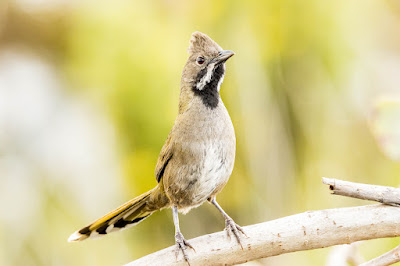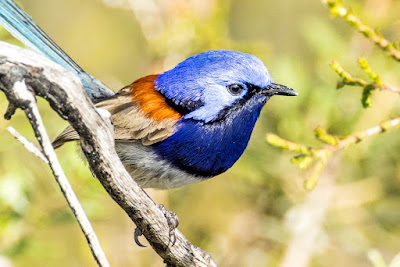Check my birding map for specific location.
Saturday, October 29, 2022
Parry's Beach
Check my birding map for specific location.
Friday, October 28, 2022
Cosy Corner
Check my birding map for specific location.
There have been a few campsites on my 2022 that have really stood out. Balgal Beach in Queensland, Kimba in South Australia and now Cosy Corner in Western Australia. Situated right on the beach, it is beautifully laid out with private bays that are limited in number. It is only 30km west of Albany and free to stay. Bonus that there are lots of birds around. I arrived during a period of heavy rain so only started to explore on my second day. There is a small lane leading east, parallel to the shore and I started there. I could hear magpies, silvereye, fairywren and fantails in the low lying bushes and further away trees. Then I came across a group of 28 Ringneck Parrots feeding. I followed them for a while and marvelled at how beautiful they are. Often overlooked as they are common, I think they are stunning birds and was happy to photograph them for as long as they would tolerate me.
I made my way back to the campsite and saw a Western Rosella. I have had brief sightings before but this was my first good look. The red of their head was so bright that it overshadowed the rest of the bird. I followed it around the toilet block (oh the glamour), getting a few funny looks from campers.
Next I walked along the entrance road for a while and could hear emu-wren. As I waited for them to possibly pop up, I was surprised to find a male Splendid Fairywren sitting on top of a bush just looking around. Where the rosella is vivid red, this guy is several shades of vivid blue. Fantastic.
The Southern Emu-wren put in an appearance further along and I had to tear myself away from the fairywren. I didn't think my shots were going to be that good of the emu-wren. It is so small that you have to get really close to get a good shot. I was surprised that they were not bad.
In the bushes behind my van I regularly heard more fairywren and I sat waiting frequently to glimpse them as they bounced around the edge of the vegetation. I could then jump out the back of the van and try to shoot them. Where the Splendid Fairywren is curious and not shy at all, the Red-winged Fairywren keeps in the gloom and I don't seem to see them as easily. This was my best shot after perching for hours in the back of my van.
eBird Lists
https://ebird.org/australia/checklist/S121353259
https://ebird.org/australia/checklist/S121280532
Sunday, October 23, 2022
Stirling Ranges
Thursday, October 20, 2022
Possum drama in Albany!
Check my birding map for specific location.
First off, I would like to say that I considered the animals' welfare before I took any actions. Shooting video and photographs were secondary to ensuring their safety.
So I am at a very pleasant caravan park on the outskirts of Albany and after some laptop drama, I am behind in my blog. I got up early this morning and was working away when I heard a loud thump. I glanced up and what looked like a branch had fallen from the tree next to the van. I didn't think much of it until it moved.
I dashed out and saw it was a possum. It looked very dazed but got up and staggered back to the tree. From a distance, I watched on and videoed it as it tried to get back up the tree. It was a bit wobbly (well, it was quite a fall) and it didn't look injured.
I turned back to the van and pulled up short. There was a baby on the ground. A tiny, very wet baby. Looked like it had just been born. Shit.
I called the park owners in desperation and we agreed to give it some space and see if mum would come back down. They would join me shortly as there was no doubt that the baby would die quickly alone in the wet grass.
Mum sat in a fork in the tree about 4 metres high. She was grooming and appeared to have recovered somewhat. From inside the van I could see her looking at the baby which was crying. I was praying and willing her on to come down and get it. She didn't. Double shit.
The park owner joined me and quickly got a ladder but as soon as he was close to mum, she bolted further up the tree. We had 2 choices - to leave the baby in the fork and hope mum would come and get it before it fell out or call the wildlife carers. The owner thought the latter was the best option. So, off the baby went and I fervently hope they can save it.
Waychinicup National Park
I knew I wanted to visit Cheynes Beach. I had been there in 2016 briefly looking for the 3 regional endemics - the Western Whipbird, the Western Bristlebird and the Noisy Scrub-bird. I was with a Birdlife Australia volunteer who was desperate to see these very rare birds. I was just happy to be seeing birds. We didn't see any of the 3 and my guide was bitterly disappointed.
Fast forward to 2022 and I am back, a better photographer and birder. I arrived at the beautiful Cheynes Beach and headed straight up the hill alongside the coastline and into the bush. I was not too far in when I heard birds calling to each other on either side of the track. I already had the whipbird from Tozer's so I knew it must be one of the other 2. I waited patiently and the calling escalated. It was the Western Bristlebird and eventually he popped up and sang for me. Pretty special and 2 out of 3 so far!
Tozer's Bush Camp, Bremer Bay
I left Ravensthorpe for Albany and decided to make a couple of stops on the way. On the western edge of the Fitzgerald National Park is Bremer Bay and just before you reach there is Tozer's Bush Camp. It is about 5km on unsealed road and as usual I hate the corrugations. But of course, the upside is that you have to go slow so you can keep an eye out for the wildlife. I knew it was going to be good when I saw a huge Emu running alongside the road and then a pair of Elegant Parrots flying past.
The camp itself is a huge surprise. The owner is a modest farmer but the camp is amazing, one of the best I have stayed in. It is packed full of plants, trees and flowers. They line all the sites and there are bush walks around the main campsite. The whole place has such a wonderful feel about it and I immediately felt at home.
As usual, I grabbed my camera and set off along one of the tracks. There was a lot of activity and I could hear a call that I didn't know, the owner sitting up on a branch far away. As soon as I looked through the long lens I knew it was a Tawny-crowned Honeyeater. I have only seen them once before on my only other visit to Western Australia in 2016. They made quite an impression with their beautiful plumage and call. It's call wasn't as pretty as I remembered but the colours were. They were common around the park so it didn't take me long to get some great shots.
I tried another of the tracks later on and immediately thought I could hear emu-wren calling from the scrub. I have never seen any species of emu-wren so they are close to top of the wish list. I stood patiently and waited for them to call again. When they didn't, I moved only. Except that as soon as I turned my back, they called again. I waited again for them and they went quiet. We repeated this process a number of frustrating times. I sometimes wish I had an easier hobby. I used to collect stamps and absolutely never did I have to worry about venomous snakes or feel that the subject was mocking me.
I returned to my van in a sulk and immediately found a pair of Western Whipbird in the bushes next to me along with a group of emu-wren. I spent the next few hours trying to get photographs of them. The whipbird move really fast and the emu-wren don't come up out of the bushes often so it was tricky but so worth it.
























































